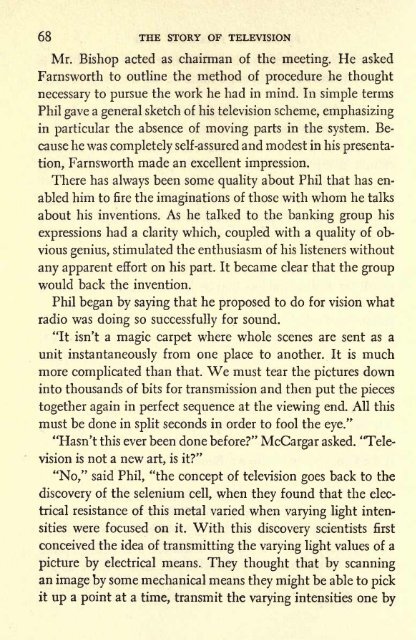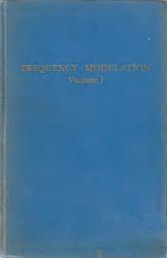the life of Philo T Farnsworth - Early Television Foundation
the life of Philo T Farnsworth - Early Television Foundation
the life of Philo T Farnsworth - Early Television Foundation
You also want an ePaper? Increase the reach of your titles
YUMPU automatically turns print PDFs into web optimized ePapers that Google loves.
68 THE STORY OF TELEVISION<br />
Mr. Bishop acted as chairman <strong>of</strong> <strong>the</strong> meeting. He asked<br />
<strong>Farnsworth</strong> to outline <strong>the</strong> method <strong>of</strong> procedure he thought<br />
necessary to pursue <strong>the</strong> work he had in mind. In simple terms<br />
Phil gave a general sketch <strong>of</strong> his television scheme, emphasizing<br />
in particular <strong>the</strong> absence <strong>of</strong> moving parts in <strong>the</strong> system. Because<br />
he was completely self-assured and modest in his presentation,<br />
<strong>Farnsworth</strong> made an excellent impression.<br />
There has always been some quality about Phil that has enabled<br />
him to fire <strong>the</strong> imaginations <strong>of</strong> those with whom he talks<br />
about his inventions. As he talked to <strong>the</strong> banking group his<br />
expressions had a clarity which, coupled with a quality <strong>of</strong> obvious<br />
genius, stimulated <strong>the</strong> enthusiasm <strong>of</strong> his listeners without<br />
any apparent effort on his part. It became clear that <strong>the</strong> group<br />
would back <strong>the</strong> invention.<br />
Phil began by saying that he proposed to do for vision what<br />
radio was doing so successfully for sound.<br />
"It isn't a magic carpet where whole scenes are sent as a<br />
unit instantaneously from one place to ano<strong>the</strong>r. It is much<br />
more complicated than that. We must tear <strong>the</strong> pictures down<br />
into thousands <strong>of</strong> bits for transmission and <strong>the</strong>n put <strong>the</strong> pieces<br />
toge<strong>the</strong>r again in perfect sequence at <strong>the</strong> viewing end. All this<br />
must be done in split seconds in order to fool <strong>the</strong> eye."<br />
"Hasn't this ever been done before" McCargar asked. "<strong>Television</strong><br />
is not a new art, is it"<br />
"No," said Phil, "<strong>the</strong> concept <strong>of</strong> television goes back to <strong>the</strong><br />
discovery <strong>of</strong> <strong>the</strong> selenium cell, when <strong>the</strong>y found that <strong>the</strong> electrical<br />
resistance <strong>of</strong> this metal varied when varying light intensities<br />
were focused on it. With this discovery<br />
scientists first<br />
conceived <strong>the</strong> idea <strong>of</strong> transmitting <strong>the</strong> varying light values <strong>of</strong> a<br />
picture by electrical means. They thought that by scanning<br />
an image by some mechanical means <strong>the</strong>y might be able to pick<br />
it<br />
up a point at a time, transmit <strong>the</strong> varying intensities one by











